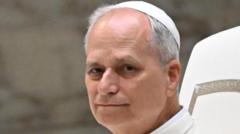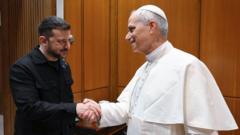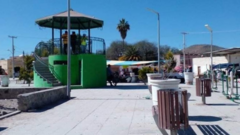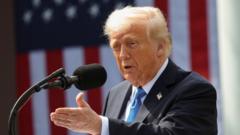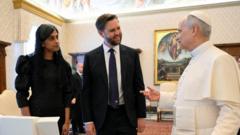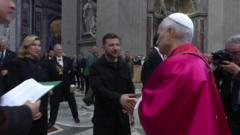As Cardinal Robert Prevost, the new Pope engages in a delicate balancing act, fostering increased women’s involvement in church leadership while maintaining traditional doctrines regarding clerical roles.
Pope Leo XIV: Women’s Roles in the Church under Scrutiny

Pope Leo XIV: Women’s Roles in the Church under Scrutiny
As Pope Leo XIV takes the papal seat, discussions around the role of women in the Catholic Church intensify, reflecting a blend of tradition and modernity.
In his past statements as cardinal, Prevost expressed skepticism about granting women the status of deacon, suggesting such changes might not simply address underlying issues within the Church. However, during his tenure as a bishop in Chiclayo, Peru, he was noted for progressively integrating women into roles within social organizations. This dual approach presents both opportunities and challenges as his papacy unfolds.
The article text:
On May 9, 2025, Cardinal Robert Francis Prevost ascended to the papacy as Pope Leo XIV, and with this transition comes pivotal discussions about the role of women within the Catholic Church. Throughout his previous tenure as cardinal, Prevost found himself entangled in debates regarding the inclusion of women as deacons, where he voiced significant reservations. He stated, “Clericalizing women would not necessarily solve problems in the church—and could perhaps create new ones,” according to remarks he made during a global assembly of bishops convened by Pope Francis in 2023, as reported by The Catholic News Agency.
Pope Leo XIV is expected to continue facing scrutiny regarding women's roles within the Church—a delicate issue that embodies a conflict between traditional practices and calls for progressive reforms. Notably, while he has made efforts to further integrate women in certain leadership capacities, he has been cautious about embracing changes that could alter longstanding doctrines.
Under his oversight at the Vatican, Prevost managed the office responsible for vetting and selecting bishops. He supported Pope Francis in expanding opportunities for women, acknowledging their contributions in what he described as a “noticeable difference” to organizational effectiveness in the office. Throughout his career, Prevost’s inclination toward elevating women’s roles can also be seen in his former bishopric in Chiclayo, Peru. Colleagues from the diocese, including Rev. Pedro Vásquez, noted his progressive approach, highlighting how he facilitated gradual change in attitudes towards women's participation.
Yolanda Díaz, a teacher within the Chiclayo diocese and an advocate for migrants and trafficking victims, praised Prevost’s efforts to expand women’s roles, indicating, “Little by little, the church has allowed us some involvement.” While he encourages the engagement of women in social pastoral work, his hesitance to fully embrace the idea of women as deacons reflects a complex balancing act likely to characterize his papacy moving forward.
As discussions continue, the Catholic community is poised to examine how Pope Leo XIV navigates the intricate landscape of women in church leadership, an endeavor that intertwines theological beliefs with evolving social expectations.
The article text:
On May 9, 2025, Cardinal Robert Francis Prevost ascended to the papacy as Pope Leo XIV, and with this transition comes pivotal discussions about the role of women within the Catholic Church. Throughout his previous tenure as cardinal, Prevost found himself entangled in debates regarding the inclusion of women as deacons, where he voiced significant reservations. He stated, “Clericalizing women would not necessarily solve problems in the church—and could perhaps create new ones,” according to remarks he made during a global assembly of bishops convened by Pope Francis in 2023, as reported by The Catholic News Agency.
Pope Leo XIV is expected to continue facing scrutiny regarding women's roles within the Church—a delicate issue that embodies a conflict between traditional practices and calls for progressive reforms. Notably, while he has made efforts to further integrate women in certain leadership capacities, he has been cautious about embracing changes that could alter longstanding doctrines.
Under his oversight at the Vatican, Prevost managed the office responsible for vetting and selecting bishops. He supported Pope Francis in expanding opportunities for women, acknowledging their contributions in what he described as a “noticeable difference” to organizational effectiveness in the office. Throughout his career, Prevost’s inclination toward elevating women’s roles can also be seen in his former bishopric in Chiclayo, Peru. Colleagues from the diocese, including Rev. Pedro Vásquez, noted his progressive approach, highlighting how he facilitated gradual change in attitudes towards women's participation.
Yolanda Díaz, a teacher within the Chiclayo diocese and an advocate for migrants and trafficking victims, praised Prevost’s efforts to expand women’s roles, indicating, “Little by little, the church has allowed us some involvement.” While he encourages the engagement of women in social pastoral work, his hesitance to fully embrace the idea of women as deacons reflects a complex balancing act likely to characterize his papacy moving forward.
As discussions continue, the Catholic community is poised to examine how Pope Leo XIV navigates the intricate landscape of women in church leadership, an endeavor that intertwines theological beliefs with evolving social expectations.




